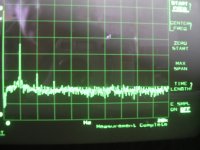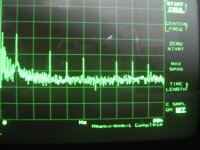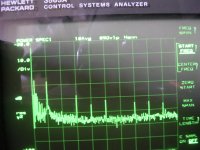Yes, the late Richard Heyser sent me on the road to becoming a 'guru' when he patiently pointed out to me, as early as 1968, that single mid frequency sine waves, contrary to the usual presumption, do NOT totally convey everything we need to know about an amp design. He didn't think much of FFT either. That is why he developed an alternate approach.
There are a lot of gnostics in audio. The rest of us have to stick to physics. There, I have erected the false dichotomy between those who can hear and those who can think. If it can be heard, then in principle it can be measured even if we haven't yet discovered how.
If two amps measure the same, yet truly sound different (I will leave others more knowledgeable than me to argue about how to establish the 'truly' criterion) then something important is not being measured. This does not mean that the measurements which are being done are irrelevant, as some claim. Some level of performance on the existing measurements is probably necessary. If you don't believe this then make up a circuit with 30% distortion (and/or 700Hz-2kHz bandwidth) and see how it sounds.
What other measurements should we do? I nominate three:
something like the Geddes metric (or the Shorter-weighted THD), RF immunity, and close-spacing IM.
With alleged resistor distortion I think it will be closed-spaced IMD which is the issue, if an issue exists. Music contains lots of closely-spaced tones (e.g overtones of instruments playing nominally the same fundamental, such as violins or a choir). Second-order distortion creates difference frequencies, which may themselves be subsonic so not directly heard. If the subsonics can find their way back into the signal chain then more second-order distortion will cause crossmodulation. Possibly candidates are PSU, inadequate supply rail decoupling, screen grid decoupling in pentode stages, thermal effects in semiconductors or resistors. If present, this effect will not show up in harmonic or conventional wide-spaced IMD measurements (so the 'ear gurus'will be happy, but it is due to normal physics so the thinkers will be happy too).
If two amps measure the same, yet truly sound different (I will leave others more knowledgeable than me to argue about how to establish the 'truly' criterion) then something important is not being measured. This does not mean that the measurements which are being done are irrelevant, as some claim. Some level of performance on the existing measurements is probably necessary. If you don't believe this then make up a circuit with 30% distortion (and/or 700Hz-2kHz bandwidth) and see how it sounds.
What other measurements should we do? I nominate three:
something like the Geddes metric (or the Shorter-weighted THD), RF immunity, and close-spacing IM.
With alleged resistor distortion I think it will be closed-spaced IMD which is the issue, if an issue exists. Music contains lots of closely-spaced tones (e.g overtones of instruments playing nominally the same fundamental, such as violins or a choir). Second-order distortion creates difference frequencies, which may themselves be subsonic so not directly heard. If the subsonics can find their way back into the signal chain then more second-order distortion will cause crossmodulation. Possibly candidates are PSU, inadequate supply rail decoupling, screen grid decoupling in pentode stages, thermal effects in semiconductors or resistors. If present, this effect will not show up in harmonic or conventional wide-spaced IMD measurements (so the 'ear gurus'will be happy, but it is due to normal physics so the thinkers will be happy too).
THe didn't think much of FFT either. That is why he developed an alternate approach.
The computer power was not there, his approach maps directly onto Fourier theory more than you think. All his results are repeatable with any of several software packages (some free) and a laptop.
With alleged resistor distortion I think it will be closed-spaced IMD which is the issue, if an issue exists. Music contains lots of closely-spaced tones (e.g overtones of instruments playing nominally the same fundamental, such as violins or a choir). Second-order distortion creates difference frequencies, which may themselves be subsonic so not directly heard.
Use an LP as your source and try to find something 80db below what the stylus makes.
OF COURSE, DF96, it is due to normal physics, but that does NOT make it necessarily easily measurable with a simple 1K tone, at least what the ear hears.
I am 'insulted' when people accuse me of making myself into a guru. I have more textbooks on physics, virtually surrounding me than most 'physicists' and certainly most 'engineers'. I have looked far and wide for the ANSWERS this past 20 years, mostly based in physics. I get 'laughed at' by people here, every time I put something forth let me give you an example:
I am 'insulted' when people accuse me of making myself into a guru. I have more textbooks on physics, virtually surrounding me than most 'physicists' and certainly most 'engineers'. I have looked far and wide for the ANSWERS this past 20 years, mostly based in physics. I get 'laughed at' by people here, every time I put something forth let me give you an example:
See what I mean? These are 2 measurements taken with my digital camera, fairly recently, with an ST-HP3563 measurement for MY reference, not to show the world. What I care about is shown on the screen, but even the SCALE was cut off, due my learning how to use the camera to take pictures from the screen.
Should I IGNORE these differences, just because I cannot 'explain' them?
Should I IGNORE these differences, just because I cannot 'explain' them?
Hi,
I often use "magic" tongue in cheek.
If I meant to indicate true Magik I would use the correct spelling.
As the Holy Church of the Meter Readers and Double Blinders routinely deny that such passive components as capacitors or resistors can make any possible difference (in fact, it's absolute tenet of faith and any who do not adhered are shunned and excommunicated), I use in this case "magic" ironically, as such a position is simple blind belief that flies in the face of the actual facts and science.
The "magic" resistor has much less excess noise and distortion than the common SMD resistors and also happened to perform well during extensive listening tests. There are quite rational reasons for the differences and no supra-natural process or entity needs to be invoked.
Ciao T
Like magic SMD resistors.
I often use "magic" tongue in cheek.
If I meant to indicate true Magik I would use the correct spelling.
As the Holy Church of the Meter Readers and Double Blinders routinely deny that such passive components as capacitors or resistors can make any possible difference (in fact, it's absolute tenet of faith and any who do not adhered are shunned and excommunicated), I use in this case "magic" ironically, as such a position is simple blind belief that flies in the face of the actual facts and science.
The "magic" resistor has much less excess noise and distortion than the common SMD resistors and also happened to perform well during extensive listening tests. There are quite rational reasons for the differences and no supra-natural process or entity needs to be invoked.
Ciao T
Sy,
Where did I say it would not be measurable?
Ciao T
But that would be completely measurable if the nearby currents are inducing an unwanted signal into the resistor.
Where did I say it would not be measurable?
Ciao T
Sy,
Where did I say it would not be measurable?
Well, the bottom line is that resistors introduce distortion that is measurable and may have effects that are are audible and not measurable.
se
As the Holy Church of the Meter Readers and Double Blinders routinely deny that such passive components as capacitors or resistors can make any possible difference (in fact, it's absolute tenet of faith and any who do not adhered are shunned and excommunicated), I use in this case "magic" ironically, as such a position is simple blind belief that flies in the face of the actual facts and science.
it is the existance of these "engineers", designing audio circuits that "that flies in the face of the actual facts and science" - care to quote some examples from this thread - must lots be here if you spend so much time warning against their simple blind beliefs
really have to dumb down your strawman for that - as I keep pointing out there's a reason there are all of those varities of caps and resistors are already available for "audiophiles" to "discover"
"real engineers" designing real products have required specific and detailed technical performance specs beyond just F in C, Ohms in R since before even Mr Curl was born
Last edited:
I would imagine physical construction (lead lengths, how the spiral is cut, inter lead capacitance and so forth) dominate over the effects being considered here.
If some parts due to geometry compensate tempco of each other, they may have different time constants. Zero statically measurable, but audible distortions of sounds. Theoretically it is possible.
Hi,
Agreed. And I would add that if we really want to make progress what must be done are listening tests that maximise sensitivity, with suitable controls, rather than making ones with predictable outcomes that minimise sensitivity.
Precisely. Or how it was said by Daniel R von Recklinghausen: "If it measures good and sounds bad, -- it is bad. If it sounds good and measures bad, -- you've measured the wrong thing."
Bandwidth, once it is wide enough there is no demonstrable improvement. As for distortion, if we for a moment ignore your 30% number (BTW, is that THD or H2 level), LP has been used as audio source for six decades and most good condition LP's do not show significant audible distortion. Yet distortion of the medium is extremely high, exceeding 10% at maximum levels easily. FM radio typically is not much better.
So anyone who has listened to LP or FM Radio knows precisely what a system with > 5..10% rated THD at maximum and monotonic distortion character (meaning both low order dominant with fast fall-off of higher harmonics AND distortion falling continuously with level) sounds like.
In fact, anyone who listens to Loudspeakers at elevated levels knows precisely what high distortion sounds like.
There is no getting away from the simple fact that the concept of "low distortion audio systems" is an impossible illusion, no matter how much true believers insist that that it is real, rather than self-delusion.
And yes, it DOES MEAN "that the measurements which are being done are irrelevant, as some claim."... Unless you deliberately make bandwidth limited limited (filtered) circuits modern electronics face no bandwidth limitations, distortion is more complex, but equally, making electronics with inaudible simple HD and simple IMD is trivial.
I would suggest that THD should be replaced by GedLee/Shorter to give an Distortion Audibility Index (as this would yield a single figure of merit that has a reasonable relation to what is audible). RF Immunity I agree with as well, as well as multi-tone or even better noise-loading.
Noiseloading (if not using digital windowed FFT) can also show what I call "Fuzzy distortion" (it is not precisely the same as that of MOH), otherwise me must engage in complex wavelet analysis of complex waveforms, so we can identify what is essentially pseudo-stochastic noise in excess of the circuits no-signal noisefloor.
I am not sure. I only can measure the problems as excess noise and/or HD when the resistors are used in very low signal level circuits, but listening tests have shown them to be audible at much higher levels where they fall below the measurement floor and should in the traditional view be inaudible.
Ciao T
If it can be heard, then in principle it can be measured even if we haven't yet discovered how.
Agreed. And I would add that if we really want to make progress what must be done are listening tests that maximise sensitivity, with suitable controls, rather than making ones with predictable outcomes that minimise sensitivity.
If two amps measure the same, yet truly sound different (I will leave others more knowledgeable than me to argue about how to establish the 'truly' criterion) then something important is not being measured.
Precisely. Or how it was said by Daniel R von Recklinghausen: "If it measures good and sounds bad, -- it is bad. If it sounds good and measures bad, -- you've measured the wrong thing."
This does not mean that the measurements which are being done are irrelevant, as some claim. Some level of performance on the existing measurements is probably necessary. If you don't believe this then make up a circuit with 30% distortion (and/or 700Hz-2kHz bandwidth) and see how it sounds.
Bandwidth, once it is wide enough there is no demonstrable improvement. As for distortion, if we for a moment ignore your 30% number (BTW, is that THD or H2 level), LP has been used as audio source for six decades and most good condition LP's do not show significant audible distortion. Yet distortion of the medium is extremely high, exceeding 10% at maximum levels easily. FM radio typically is not much better.
So anyone who has listened to LP or FM Radio knows precisely what a system with > 5..10% rated THD at maximum and monotonic distortion character (meaning both low order dominant with fast fall-off of higher harmonics AND distortion falling continuously with level) sounds like.
In fact, anyone who listens to Loudspeakers at elevated levels knows precisely what high distortion sounds like.
There is no getting away from the simple fact that the concept of "low distortion audio systems" is an impossible illusion, no matter how much true believers insist that that it is real, rather than self-delusion.
And yes, it DOES MEAN "that the measurements which are being done are irrelevant, as some claim."... Unless you deliberately make bandwidth limited limited (filtered) circuits modern electronics face no bandwidth limitations, distortion is more complex, but equally, making electronics with inaudible simple HD and simple IMD is trivial.
What other measurements should we do? I nominate three:
something like the Geddes metric (or the Shorter-weighted THD), RF immunity, and close-spacing IM.
I would suggest that THD should be replaced by GedLee/Shorter to give an Distortion Audibility Index (as this would yield a single figure of merit that has a reasonable relation to what is audible). RF Immunity I agree with as well, as well as multi-tone or even better noise-loading.
Noiseloading (if not using digital windowed FFT) can also show what I call "Fuzzy distortion" (it is not precisely the same as that of MOH), otherwise me must engage in complex wavelet analysis of complex waveforms, so we can identify what is essentially pseudo-stochastic noise in excess of the circuits no-signal noisefloor.
With alleged resistor distortion I think it will be closed-spaced IMD which is the issue, if an issue exists. Music contains lots of closely-spaced tones (e.g overtones of instruments playing nominally the same fundamental, such as violins or a choir).
I am not sure. I only can measure the problems as excess noise and/or HD when the resistors are used in very low signal level circuits, but listening tests have shown them to be audible at much higher levels where they fall below the measurement floor and should in the traditional view be inaudible.
Ciao T
- Status
- Not open for further replies.
- Home
- Member Areas
- The Lounge
- John Curl's Blowtorch preamplifier part II


